Generation Digital
Consider this: young mom and dad enter a restaurant with their two-year old in a prom. For the child not to disturb them during romantic meal they give him/her a tablet with cartoons and games. A child is too young to speak well but is very proficient in operating the complex digital device.
In other words, we are confidently entering a new dimension of digital life that is dominated by screens of all sorts. Screens may be large or small, complex or simplified, intelligent, interactive etc. Whatever the case, we are spending our lives staring at screens from morning till evening, and not infrequently, even at night.
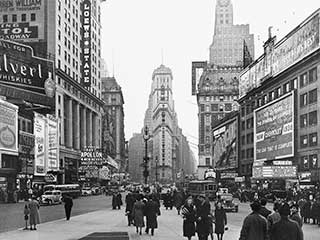 |
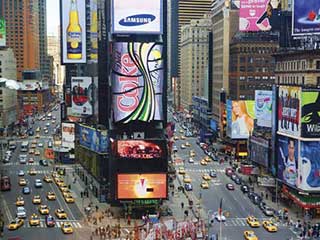 |
| Evolution of outdoor advertising at Times Square | |
As a result our perception starts to change gradually. Static images are still common but we definitely prefer dynamic images. Perception adjusts to the changing conditions, to the ever-present screens, to new technological advances in screen technology. Methods of displaying information also change: dynamic imaging is more convincing, it affects our perception stronger. Today advertisers and PR experts regularly come up with new ways of breaching our defenses against persuasion, accessing our conscious and subconscious mind to deliver indelible instructions about what to buy and who to elect.
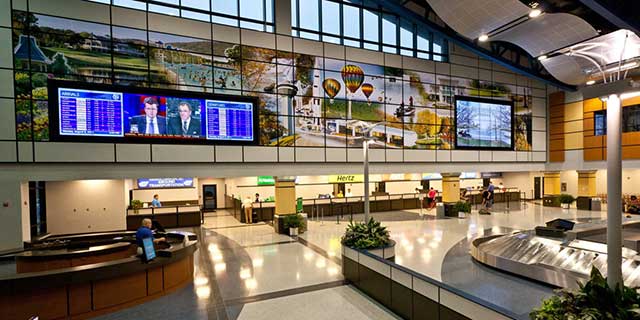
Modern digital out-of-home advertising (DOOH)
TV screens have taken over our personal space (homes) and keep on multiplying. The public space (city streets and squares) continue to resist weakly, inefficiently and uselessly. Advertising screen systems in the form of huge LED screens, slim dynamic signs, gigantic media façades or relatively small outdoor interactive LCD displays occupy all cities around the world.
The first to realize the indisputable advantages of new carriers were large advertising networks. They (Clear Channel, JCDecaux and others) started implementing new technology and redistribute the market between themselves. It was a risky venture: 10 years ago the price of LED outdoor systems was 10 times what it is today. Add to this heavy expenses on installation and permits and it becomes clear why only the heavyweights could work with dynamic outdoor systems. We have to admit that they make a good job of educating the public and getting us used to new ideas, technologies and new structure of network business.
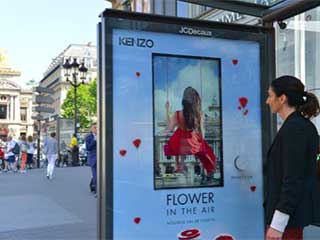 |
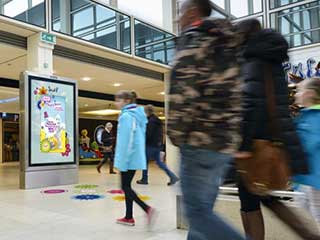 |
| JCDecaux bus shelter LCD display | Digital signage in shopping mall |
Today dynamic digital systems (DDS) are actively penetrating small and medium business. The average dynamic digital signage sale is five screens (in different variations: LCD screens, LED signboards, outdoor LED billboards or screens). However, it is the acceptance of digital advertising by the small business that gives a new impetus for the manufacturers of screens around the world. Dynamic digital screens become the major carrier of information both social and commercial.
In a recent New York Times article it was stated that 68% of city population see dynamic digital signage every day. We should not forget that experts estimate that nowadays people spend up to 8 hours a day on average in front of a screen of one type or other every day. These screens include not only PC monitors at work and TV screens at home, but numerous informational screens in shops and on transport and outdoor LED screens in city streets.
Modern person gets used to absorbing information via dynamic screens. Any other presentation of material becomes psychologically “slow” and therefore dull. Recent research shows that dynamic signs receive 10 times more eye contact than traditional static signage. This means that the impact of the dynamic advertising on a potential consumer is nearly ten times stronger. The time spent viewing video advertising is later converted into better brand recognition and subconscious choice of advertised products.
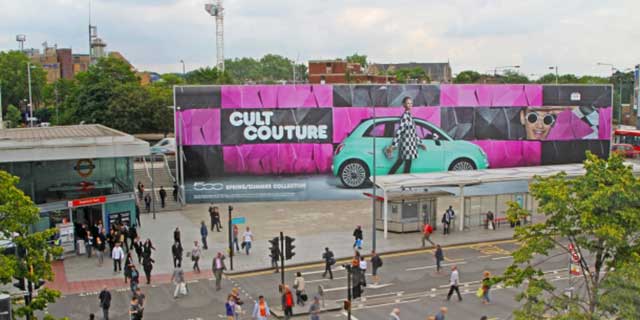
Fiat 'Cult Couture' on The Wall @ Westfield of Ocean Outdoor
Convincing statistics. Meanwhile the prices on LED and other types of digital screens continue to fall. For this reason the advertising portfolio of many small and medium-sized companies is equally split between static and dynamic advertising. And screens start to gradually win the battle.
Easy maintenance and control, instantaneous upgrade of content, simple procedures in compiling playlists, possibility of adapting messages to different audience during the day, or even during weekends and public holidays – all these advantages convince owners of small businesses, of shops, restaurants, cafes, drugstores, drycleaners, filling stations and carwashes to make a choice in favor of digital dynamic advertising. The choice is reasonable and justifiable: digital advertising is significantly more effective in achieving all major advertising goals:
- brand building;
- increased sales and turnover of goods;
- dissemination of information about business;
- wayfinding amid city jungle;
- improved viewer/customer experience.
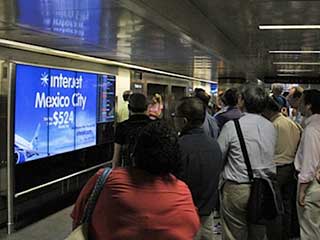 |
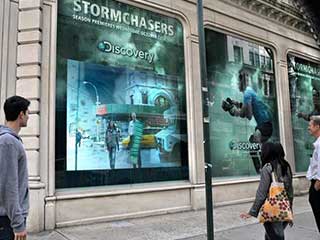 |
| New York Penn Station digital signage | Inwindow Outdoor promote the Discovery Channel series “Storm Chasers” |
Having chosen digital advertising, business owners frequently face a serious problem: enormous choice of different devices (screen systems - hardware) and control methods (software). Luckily there are plenty of operating systems in every city to look at, compare and enquire about. What remains is to plan the installation thoroughly so that the installed screens fully cover the useful floor space and key areas where potential customers traditionally make decisions about buying. Video advertising and prompting stimulates active consumer behavior much more effectively as compared to static advertising and leaflets.
Being used to watch video from childhood, we are easily conditioned by video imagery and skillfully crafted video instructions. A new digital generation is growing up and soon there will be no people left who have problems in navigating tablets and vendor street display systems, who prefer printed texts to digital, who prefer to read “Gone with the Wind” rather than watch video versions. Life is moving on! To new digital dimensions!





